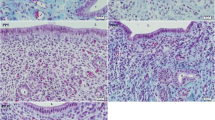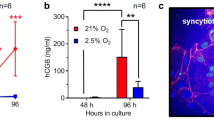Summary
The processing of epidermal growth factor (EGF) and its receptor in human trophoblast during the first trimester and at term was studied using biotinlabeled EGF, an anti-EGF receptor monoclonal antibody and immunohistochemistry. In chorionic villi incubated with EGF-biotin the ligand was first bound to specific receptors on the synytial surface, which are in contact with the maternal blood. After 2–5 min in the early gestation placenta, EGF-biotin was found at the basal plasma membrane of the syncytium accompanied by a pronounced EGF receptor immunostaining. In contrast, in the term placenta, immunostaining of EGF-biotin as well as EGF receptors was pronouced in the syncytioplasma within 30–60 min following EGF stimulation; in addition, EGF-biotin was found in some syncytial nuclei. These immunostaining reactions were enhanced after lysosomal blockage by chloroquine. The results reveal a transsyncytial, receptor-mediated transfer of EGF from the maternal blood to the cytotrophoblast, the proliferating part of the trophoblast, in the first trimester placenta. However, in the term placenta, the EGF signal seems to be directed primarily to the syncytium, thus probably influencing differentiated functions. In conclusion, the trophoblast examplifies three possible pathways of EGF processing: 1. transcytotic transfer, 2. direct intracellular signalling followed by lysosomal degradation, and 3. nuclear binding.
Similar content being viewed by others
References
Arnholdt H, Meisel F, Bäther K, Löhrs U (1988) Trophoblastproliferation und-differenzierung in normalen und pathologischen Plazenten. Verh Dt Ges Pathol 72:497
Arnholdt H, Meisel F, Fandrey K, Löhrs U (1991) Proliferation of villous trophoblast of the human placenta in normal and abnormal pregnancies. Virch Arch [B] 60:365–372
Aulinskas TH, van der Westhuyzen DR, Bierman EL, Gevers W, Coetzee GA (1981) Retro-endocytosis of low density lipoprotein by cultured bovine aortic smooth muscle cells. Biochim Biophys Acta 664:255–265
Bar RS, Boes M, Sandra A (1988) Vascular transport of insulin of rat cardiac muscle. J Clin Invest 81:1225–1233
Benveniste R, Speeg KV, Carpenter G, Cohen S, Lindner J, Rabinowitz D (1978) Epidermal growth factor stimulates secretion of human chorionic gonadotropin by cultured human choriocarcinoma cells. J Clin Endocrinol Metabol 46:169–172
Burwen SJ, Barker ME, Goldman IS, Hradek GT, Raper SE, Jones AL (1984) Transport of epidermal growth factor by rat liver: evidence for a nonlysosomal pathway. J Cell Biol 99:1259–1265
Chegini N, Rao CV (1986) Quantitative electron microscopic autoradiographic studies on internalization of125I-labelled epidermal growth factor in term human placenta. J Cell Sci 84:41–52
Chen C-F, Kurachi H, Fujita Y, Terakawa N, Miyake A, Tanizawa O (1988) Changes in epidermal growth factor receptor and its messenger ribonucleic acid levels in human placenta and isolated trophoblast cells during pregnancy. J Clin Endocrinol Metabol 67:1171–1177
Cordell JL, Falini B, Erber WN, Ghosh AK, McDonald S, Pulford KA, Stein H, Mason DY (1984) Immunoenzymatic labeling of monoclonal antibodies using immune complexes of alkaline phosphatase and monoclonal anti-alkaline phosphatase (APAAP complexes). J Histochem Cytochem 32:219–229
Dernovsek KD, Bar RS, Ginsberg BH, Lioubin MN (1984) Rapid transport of biologically intact insulin through cultured endothelial cells. J Clin Endocrinol Metabol 58:761–763
Eaton BM, Richards RC, Contractor SF (1987) Uptake and metabolism of epidermal growth factor in the perfused human placenta. J Dev Physiol 9:69–78
Ezaki O, Kasuga M, Akanuma Y, Takata K, Hirano H, Fujita-Yamaguchi Y, Kasahara M (1986) Recycling of the glucose transporter, the insulin receptor, and insulin in rat adipocytes. J Biol Chem 261:3295–3305
Gerbie AB, Hathaway HH, Brewer JI (1968) Autoradiographic analysis of normal trophoblastic proliferation. Am J Obstet Gynecol 100:640–648
Han VKM, Hunter ES, Pratt RM, Zendegui JG, Lee DC (1987) Expression of rat transforming growth factor alpha mRNA during development occurs predominantly in the maternal decidua. Mol Cell Biol 7:2335–2343
Harding C, Heuser J, Stahl P (1983) Receptor-mediated endocytosis of transferrin and recycling of the transferrin receptor in rat reticulocytes. J Cell Biol 97:329–339
Hsu SM, Raine L, Fanger H (1981) Use of avidin-biotin-peroxidase complex (ABC) in immunoperoxidase techniques: A comparison between ABC and unlabelled antibody (PAP) procedures. J Histochem Cytochem 29:577–580
Jialal I, King GL, Buchwald S, Kahn CR, Crettaz M (1984) Processing of insulin by bovine endothelial cells in culture. Diabetes 33:794–800
Kaufmann P (1972) Untersuchungen über die Langhanszellen in der menschlichen Placenta. Z Zellforsch 128:283–302
King GL, Johnson SM (1985) Receptor-mediated transport of insulin across endothelial cells. Science 227:1583–1586
Levy JR, Olefsky JM (1986) Retroendocytosis of insulin in rat adipocytes. Endocrinology 119:572–579
Levy JR, Olefsky JM (1987) The trafficking and processing of insulin and insulin receptors in cultured rat hepatocytes. Endocrinology 121:2075–2086
Maratos-Flier E, Kao C-YY, Verdin EM, King GL (1987) Receptor-mediated vectorial transcytosis of epidermal growth factor by madin-darby canine kidney cells. J Cell Biol 105:1595–1601
Marshall S (1985) Dual pathways for the intracellular processing of insulin. J Biol Chem 260:13524–13531
Maruo T, Matsuo H, Oishi T, Hayashi M, Nishino R, Mochizuki M (1987) Induction of differentiated trophoblast function by epidermal growth factor: relation of immunohistochemically detected cellular epidermal growth factor receptor levels. J Clin Endocrinol Metabol 64:744–750
Maruo T, Mochizuki M (1987) Immunohistochemical localization of epidermal growth factor receptor and myc oncogene product in human placenta: implication for trophoblast proliferation and differentiation. Am J Obstet Gynecol 156:721–727
Morrish DW, Bhardwaj D, Dabbagh LK, Marusyk H, Siy O (1987) Epidermal growth factor induces differentiation and secretion of human chorionic gonadotropin and placental lactogen in normal human placenta. J Clin Endocrinol Metabol 65:1282–1290
Rakowicz-Szulczynska EM, Rodeck U, Herlyn M, Koprowski H (1986) Chromatin binding of epidermal growth factor, nerve growth factor, and platelet-derived growth factor in cells bearing the appropriate surface receptors. Biochemistry 83:3728–3732
Ramani N, Chegini N, Rao CV, Woost PG, Schultz GS (1986) The presence of epidermal growth factor binding sites in the intracellular organelles of term human plancenta. J Cell Sci 84:19–40
Rao CV, Ramani N, Chegini N, Stadig BK, Carman FR, Woost PG, Schultz GS, Cook CL (1985) Topography of human placental receptors for epidermal growth factor. J Biol Chem 260:1705–1710
Raper SE, Burwen SJ, Barker ME, Jones AL (1987) Translocation of epidermal growth factor to the hepatocyte nucleus during rat liver regeneration. Gastroenterology 92:1243–1250
Renston RH, Jones AL, Christiansen WD, Hradek GT (1980a) Evidence for a vesicular transport mechanism in hepatocytes for biliary secretion of immunoglobulin A. Science 208:1276–1278
Renston RH, Maloney DG, Jones AL, Hradek GT, Wong KY, Goldfine ID (1980b) Bile secretory apparatus: evidence for a vesicular transport mechanism for proteins in the rat, using horseradish peroxidase and125I-insulin. Gastroenterology 78:1373–1388
Smith RM, Jarett L (1983) Quantitative ultrastructural analysis of receptor-mediated insulin uptake into adipocytes. J Cell Physiol 115:199–207
Vandeurs B, Bulow von F, Moller M (1981) Vesicular transport of cationized ferritin by the epithelium of the rat choroid plexus. J Cell Biol 89:131–139
Wilson EA, Jawad MJ, Vernon MW (1984) Effect of epidermal growth factor on hormone secretion by term placenta in organ culture. Am J Obstet Gynecol 149:579–580
Author information
Authors and Affiliations
Rights and permissions
About this article
Cite this article
Arnholdt, H., Diebold, J., Kuhlmann, B. et al. Receptor-mediated processing of epidermal growth factor in the trophoblast of the human placenta. Virchows Archiv B Cell Pathol 61, 75–80 (1992). https://doi.org/10.1007/BF02890407
Received:
Accepted:
Issue Date:
DOI: https://doi.org/10.1007/BF02890407




